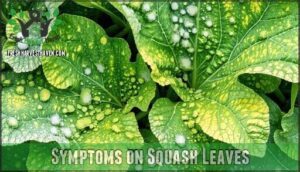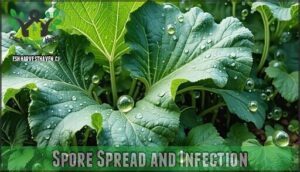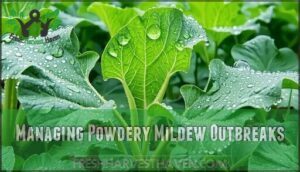This site is supported by our readers. We may earn a commission, at no cost to you, if you purchase through links.
 When treating powdery mildew on squash, you’ll need to act fast since this fungal disease spreads like wildfire, covering entire leaves within 3-7 days.
When treating powdery mildew on squash, you’ll need to act fast since this fungal disease spreads like wildfire, covering entire leaves within 3-7 days.
Start by removing infected leaves with sterilized pruning shears, then apply neem oil weekly or use a baking soda spray (1 tsp per quart water) for mild infections.
For severe outbreaks, sulfur-based fungicides work best when applied during morning hours.
The key is maintaining strict garden hygiene—disinfect tools and remove all debris to prevent reinfection, and remember that your timing matters more than you might think, as act fast is crucial in controlling the disease.
Table Of Contents
- Key Takeaways
- Identifying Powdery Mildew
- Causes of Powdery Mildew
- Preventing Powdery Mildew
- Treating Powdery Mildew
- Managing Powdery Mildew Outbreaks
- Frequently Asked Questions (FAQs)
- How do you treat powdery mildew in squash?
- What causes powdery mildew on squash leaves?
- What makes milk effective against mildew on squash?
- How do I get rid of powdery mildew on my squash plants?
- What is the most effective treatment for powdery mildew?
- What can I spray on squash for mildew?
- Is baking soda or milk better for powdery mildew?
- Can powdery mildew affect squash fruit quality?
- How long does powdery mildew treatment take?
- Will powdery mildew return next growing season?
- Conclusion
Key Takeaways
- Act fast to remove infected leaves – You’ll need to cut off diseased foliage with sterilized pruning shears immediately, as powdery mildew can spread across entire leaves within 3-7 days if left untreated.
- Apply weekly treatments consistently – You should spray neem oil or baking soda solution (1 tsp per quart water) every 7 days for mild infections, or use sulfur-based fungicides during morning hours for severe outbreaks.
- Maintain strict garden hygiene – You must disinfect all tools between plants and remove infected debris completely, since contaminated equipment and plant matter create pathways for spores to spread throughout your garden.
- Focus on prevention through proper spacing – You’ll prevent future outbreaks by planting resistant varieties 3-4 feet apart, ensuring good air circulation, and watering at soil level to avoid creating the humid conditions that powdery mildew thrives in.
Identifying Powdery Mildew
You’ll recognize powdery mildew by the telltale white, dusty spots that appear on squash leaves, looking like someone dusted them with talcum powder.
These small patches start on young leaves and can spread to cover entire leaves within 3-7 days, eventually causing them to turn yellow, brown, and shrivel up.
Watch those white spots spread fast—your squash leaves can go from healthy to shriveled in just one week.
Symptoms on Squash Leaves
The first telltale signs of squash powdery mildew appear as small, white powdery spots scattered across leaf surfaces like talcum powder.
These microscopic fungal colonies quickly spread, causing yellowing leaves and leaf damage within days.
As fungal growth progresses, you’ll notice squash decline with leaves turning pale yellow, then brown, creating vulnerable conditions for your squash plant care routine.
Implementing preventative measures can substantially reduce the risk of infection.
Spore Spread and Infection
Powdery mildew spreads through microscopic fungal spores that travel on wind currents, reaching your squash plants from infected gardens miles away. Initial infection occurs when conidia dissemination deposits spores onto leaf surfaces, where they germinate within hours under favorable environmental conditions.
Spore overwintering in soil debris guarantees reinfection each growing season, while rapid colonization creates visible symptoms in just 3-7 days. The disease’s host specificity means squash varieties face targeted attacks from specialized fungal species.
Key factors accelerating mildew spread include:
- Dense plantings that concentrate airborne spores
- Poor air circulation trapping humidity around leaves
- Infected plant debris harboring overwintering spores
Fungal Species and Host Plants
Understanding fungal identification helps you target your squash’s specific enemy.
Three primary species cause powdery mildew in cucurbits, each with distinct host specificity patterns and spore overwintering strategies.
- Podosphaera xanthii dominance – This aggressive fungal disease thrives in warm climates, making your squash vulnerable
- Golovinomyces cucurbitacearum persistence – Cold-hardy spores survive harsh winters, ensuring genetic resistance becomes essential
- Disease cycle complexity – Multiple species can attack simultaneously, complicating treatment approaches
- Regional variation impact – Your location determines which species you’ll battle most frequently
Causes of Powdery Mildew
Understanding what causes powdery mildew helps you prevent future outbreaks on your squash plants. This fungal disease thrives in specific environmental conditions that you can control through proper garden management.
Weather and Temperature Factors
Weather patterns substantially impact powdery mildew development on your squash plants.
Temperature swings between day and night create ideal conditions, while dry heat combined with nighttime humidity accelerates spore germination.
Shaded areas trap moisture and warmth, promoting fungal growth.
Conversely, adequate sunlight exposure helps reduce infection rates by drying leaf surfaces and creating less favorable conditions for this persistent weather-dependent disease.
Lack of Sunlight and Humidity
Your squash plants need at least six hours of daily sunlight exposure to prevent powdery mildew.
Shade impact creates humidity effects that encourage spore germination around leaves.
Dense plantings trap moisture and reduce airflow importance, creating optimal conditions for fungal growth.
You can’t achieve effective mildew prevention without proper sun exposure and air circulation through your garden.
Wind and Infected Soil
Through wind trajectory, powdery mildew spores travel miles from infected gardens to healthy squash plants.
Powdery mildew spores ride the wind for miles, silently hunting your healthy squash plants
Overwintering fungi in soil inoculum survive winter conditions, creating persistent infection sources that reactivate during favorable growing seasons.
This fungal disease spreads through spore dispersal mechanisms that enable regional spread across neighborhoods.
Effective mildew prevention requires understanding these transmission pathways to protect your crops from plant diseases.
- Wind carries spores up to several miles from infected source plants
- Contaminated soil harbors overwintering fungi for multiple growing seasons
- Garden tools transfer soil inoculum between healthy and diseased plants
- Regional spread occurs through airborne spore dispersal during warm weather
- Infected plant debris creates localized spore reservoirs near squash plantings
Preventing Powdery Mildew
You can prevent powdery mildew on squash by choosing resistant varieties and creating ideal growing conditions.
Proper spacing, watering techniques, and fertilization practices will keep your plants healthy and reduce infection risk, which is crucial for preventing powdery mildew.
Planting Resistant Squash Varieties
Your best defense starts with variety selection that targets powdery mildew before it appears.
Mildew resistant squash like Autumn Delight and Success PM Yellow demonstrate hybrid vigor and disease resistance through advanced plant breeding.
These varieties maintain 60-80% higher yields under pressure than susceptible types.
Regional adaptations matter—Metro PMR thrives in northeastern climates while Sweet REBA performs well in southern conditions.
Consider grafting options for enhanced resistance, though seed saving from hybrids won’t preserve resistance traits.
Newer varieties offer powdery mildew resistance, reducing the need for fungicides.
Increasing Air Circulation and Space
Think of air circulation as your garden’s natural defense system against powdery mildew on squash.
Plant spacing of 3-4 feet apart reduces plant density and creates airflow optimization that prevents stagnant moisture buildup.
Pruning techniques remove lower leaves blocking airflow, while proper spacing guarantees sunlight exposure reaches all plant surfaces.
These spacing benefits create an environment where mildew prevention happens naturally, as spores can’t establish in well-ventilated areas with consistent air movement.
Regular applications of neem oil treatment can further disrupt fungal growth.
Proper Watering and Fertilization
Around your garden, proper watering techniques and fertilization create a protective shield against powdery mildew.
Water at soil level using drip irrigation to prevent leaf moisture that encourages fungal growth. Nutrient balance matters—excess nitrogen weakens plant immunity while steady nutrition strengthens disease resistance.
Consider using a complete drip system for ideal water delivery.
- Morning watering allows quick leaf drying, reducing infection risk
- Slow-release fertilizers maintain consistent nutrient balance without over-fertilization
- Soil moisture monitoring prevents drought stress and waterlogged conditions that compromise soil health
Treating Powdery Mildew
When powdery mildew appears on your squash, you’ll need to act fast to save your plants and prevent the fungus from spreading throughout your garden.
The good news is that several proven treatments can stop this white, dusty menace in its tracks when applied correctly, which is a critical step in saving your plants.
Removing Infected Leaves and Stems
When prevention falls short, swift action becomes your best defense against squash powdery mildew treatment. Remove infected leaves immediately using clean, sharp pruning shears for precise cuts.
Tool sterilization with rubbing alcohol between plants prevents cross-contamination and stops re-infection prevention efforts from failing. Cut back to healthy tissue, examining each section carefully before proceeding.
Sanitation importance can’t be overstated—bag all infected material for trash disposal, never composting contaminated debris. Consider using specialized squash shears for superior plant health.
This aggressive pruning technique eliminates fungal spores and reduces available surfaces for mildew treatment needs. Proper disposal methods guarantee your squash disease management strategy succeeds, protecting remaining healthy foliage from further infection spread.
Using Fungicides and Natural Controls
After removing infected material, neem oil and baking soda solutions provide effective organic solutions for powdery mildew control on squash.
Sulfur-based fungicides deliver superior results for severe infections when applied during morning hours.
One common issue is white dusty spots appearing on the leaves.
- Apply neem oil weekly as preventative treatment
- Use baking soda spray (1 tsp per quart water) for mild infections
- Choose sulfur fungicides for severe outbreaks requiring chemical intervention
- Avoid copper fungicides due to potential leaf damage on squash plants
Improving Garden Sanitation and Hygiene
Since plant debris and contaminated tools create highways for spore transmission, maintaining strict garden hygiene becomes your first line of defense.
Disinfecting tools with rubbing alcohol after handling infected plants prevents cross-contamination between healthy squash.
Remove all plant debris from garden beds immediately—fallen leaves harbor overwintering spores that reactivate under favorable conditions.
Debris removal should include weeds that compete for nutrients and harbor pathogens.
Practice thorough tool sanitation and hand washing between plants to break the infection cycle effectively.
Managing Powdery Mildew Outbreaks
Once you’ve detected powdery mildew on your squash plants, you’ll need to act fast to prevent it from spreading throughout your entire garden.
The key is combining smart monitoring with targeted treatments that address both current infections and future prevention strategies, which is crucial for complete concepts like preventing the spread of powdery mildew.
Monitoring Weather and Humidity
Track humidity levels above 60% and temperature fluctuations between cool nights and warm days when powdery mildew strikes hardest.
Weather patterns with high humidity thresholds create perfect microclimate effects for spore germination.
Monitor leaf wetness duration, especially in shaded garden areas where mildew symptoms develop fastest.
Plant diseases flourish when moisture lingers on foliage overnight.
Practicing Crop Rotation and Soil Care
Crop rotation disrupts powdery mildew’s lifecycle when you plant non-cucurbit crops for two to four years.
Rotation Benefits include reduced spore counts and improved Soil Health through Nutrient Cycling.
Enhanced Cover Cropping and strategic Compost Application strengthen plant resistance, making your squash less vulnerable to future infections.
Tomato plants also benefit from increased sunlight and airflow to prevent powdery mildew.
Using Organic and Chemical Controls Effectively
Battling stubborn powdery mildew requires smart fungicide rotation between organic and chemical applications.
Start with organic fungicides like sulfur, then alternate with different chemical classes for resistance management.
This integrated approach delivers 92% disease reduction when you follow safe handling protocols and maintain weekly application schedules for maximum powdery mildew prevention.
Many gardeners effectively use organic options available to control squash fungus.
Frequently Asked Questions (FAQs)
How do you treat powdery mildew in squash?
Don’t assume fungicides alone will save your squash—prevention beats treatment every time.
Remove infected leaves immediately, apply neem oil or baking soda solution weekly, improve air circulation, and water at soil level to prevent reinfection.
What causes powdery mildew on squash leaves?
Powdery mildew develops when specific fungi (Podosphaera xanthii and Golovinomyces cucurbitacearum) find ideal conditions: warm temperatures between 60-90°F, high humidity, poor air circulation, and crowded plantings.
These conditions create perfect fungal breeding grounds, allowing the disease to thrive in environments with warm temperatures.
What makes milk effective against mildew on squash?
Studies show milk’s proteins create a 40% reduction in spore germination rates.
You’ll find that milk’s lactoferrin and immunoglobulins directly inhibit fungal growth while changing leaf surface pH levels.
This natural antifungal action disrupts the mildew’s lifecycle effectively.
How do I get rid of powdery mildew on my squash plants?
Remove infected leaves immediately and spray remaining foliage with neem oil or baking soda solution (1 tablespoon per gallon) every week until symptoms disappear.
What is the most effective treatment for powdery mildew?
Like a knight wielding a gleaming sword against an invisible enemy, you’ll find neem oil your most potent weapon.
Apply it every seven days, targeting all leaf surfaces thoroughly for maximum effectiveness.
What can I spray on squash for mildew?
You can spray baking soda solution (one tablespoon per gallon), neem oil, sulfur-based fungicides, or milk on infected squash leaves every seven to ten days for effective control.
Is baking soda or milk better for powdery mildew?
You might think both work equally well, but milk’s actually more effective than baking soda for powdery mildew.
Milk contains proteins that boost your plant’s immune system while creating an alkaline surface that stops fungal spores from germinating properly, which makes it a more effective solution due to its ability to boost your plant’s immune system.
Can powdery mildew affect squash fruit quality?
Yes, powdery mildew substantially impacts squash fruit quality. The disease causes leaves to die back, exposing your precious squash to sunscald damage that creates unsightly blemishes and reduces marketability.
How long does powdery mildew treatment take?
Persistent powdery problems require patient treatment timing.
You’ll need consistent fungicide applications every 7-10 days for 3-4 weeks to see significant improvement, though healthy new growth appears sooner with proper care.
Will powdery mildew return next growing season?
Powdery mildew often returns because fungal spores overwinter in soil and infected debris. You’ll need to practice crop rotation, plant resistant varieties, and maintain proper spacing to break the cycle.
Conclusion
Can you truly claim victory over powdery mildew without consistent monitoring?
Successfully treating powdery mildew on squash requires dedication beyond the initial intervention. You’ll need to maintain weekly fungicide applications, continue removing infected foliage, and monitor weather patterns that favor reinfection.
Remember that prevention remains more effective than treatment—proper spacing, resistant varieties, and good air circulation substantially reduce future outbreaks.
Your vigilance in garden sanitation and early detection will determine long-term success against this persistent fungal disease.
- https://s3.wp.wsu.edu/uploads/sites/403/2015/03/milk-and-roses.pdf
- https://extension.colostate.edu/topic-areas/yard-garden/powdery-mildews-2-902/
- https://www.vegetables.cornell.edu/pest-management/disease-factsheets/disease-resistant-vegetable-varieties/disease-resistant-cucurbit-varieties/
- https://www.adaptiveseeds.com/product/vegetables/squash/summer-squash/zucchini-mutabile-organic/
- https://fieldreport.caes.uga.edu/news/uga-researcher-identifies-healthiest-winter-squash-varieties/










